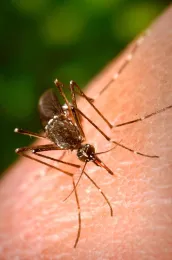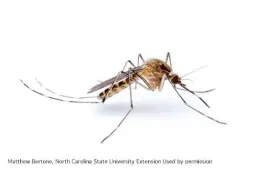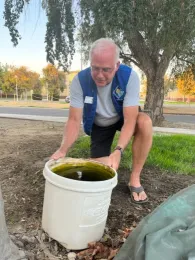
Vampires are mythic undead humans who sleep during the day and hunt for blood at night. However, we have our own very real and very much alive bloodsucking vampires - mosquitoes! Unlike vampires, some mosquitoes are active during the daytime and may be out with the ghosts, goblins and witches during Halloween!
To be accurate, only female mosquitoes bite us. The smaller males don’t bite at all. The normal food for both sexes is nectar from flowers. While not major pollinators, as they move from flower-to-flower mosquitoes can be accidental pollinators.
Female mosquitoes require protein when getting ready to lay eggs, which she obtains via blood from humans and other vertebrate animals. A single female will lay eggs multiple times during her short lifetime of a few weeks to two months, depending on species. While vampires have two sharp fangs, a female mosquito’s mouth (called a proboscis) is a sophisticated system with six tiny needle-like parts that pierce the skin and inject saliva with anticoagulants (which can cause swelling and itching at the injection site) allowing blood to flow freely to suck up.
Mosquitoes are more than just an annoyance when they bite us. While a female mosquito is consuming blood, she can unwittingly acquire a virus or parasite from a vertebrate animal or another human and then transmit to us potentially dangerous diseases such as Zika, West Nile virus, encephalitis, malaria, and chikungunya. If infected, the person will likely be asymptomatic or have mild symptoms. However, a small percentage of people can become very ill, suffer side effects, and possibly die.
California Mosquitoes

California is home to more than 50 species of mosquitoes. Many are uncommon, are not a nuisance nor pose a threat to human health. Only those that feed on people are a potential danger, including some from the genera Aedes and Culex. Here are some species that can be found in our area:
Aedes aegypti (Yellow fever mosquito) are members of the invasive Aedes group from Africa. Generally smaller than other mosquitoes, they are sometimes called “no-see-ums.” Dr. Wakoli Wekesa, director of East Side Mosquito Abatement District, which monitors mosquito populations in Stanislaus County north of the Tuolumne River (including Modesto), states that A. aegypti first appeared in Stanislaus County in 2019. Because they are an invasive species who have been here for a short time, they have virtually no predators. As a result, their populations have significantly increased during the past 2-3 years, making them the main source of mosquito bites. (https://www.eastsidemosquito.com/).
Found both indoors and outdoors, A. aegypti are active both day and night. Feeding primarily on humans, they are aggressive biters, often targeting ankles, wrists and elbows. Their eggs are capable of surviving over winter and hatching year-round. A small, dark colored mosquito with distinctive black and white marks on their legs, they can spread Zika, dengue and chikungunya viruses. This map shows Aedes distribution in California: https://www.cdph.ca.gov/Programs/CID/DCDC/CDPH%20Document%20Library/AedesDistributionMap.pdf ).
Culex are a group of native mosquitoes which are widespread throughout North America. C. pipiens (Northern house mosquito) are light brown urban mosquitoes often found in our homes. C. tarsalis (Western encephalitis mosquito) are found in both urban and rural areas, and have distinct inverted V-shaped dark markings on their abdomen. Both species are most active during the summer and fall months at nighttime, who prefer feeding on birds but will also feed on humans. Both can spread the West Nile and St. Louis encephalitis viruses.
Mosquito Activity

We tend to think of mosquitoes being active only during dusk and dawn, but as the Aedes and Culex species show, some mosquitoes are also out during daylight hours and others at night.
Traditionally mosquitoes are thought to disappear during the cooler seasons, so we expect them to be gone by Halloween. As this graphic from the California Dept. of Public Health shows, while mosquitoes are more prevalent during warmer months, some can still be around during late autumn and even during winter months.
https://www.cdph.ca.gov/Programs/CID/DCDC/CDPH%20Document%20Library/SeasonalMosquitoRiskGraphic.pdf
Protecting Ourselves
Native California mosquitoes have various natural predators including bats, birds, dragonflies, and aquatic insects that eat adult mosquitoes and larvae. Invasive species may have few natural predators, making them harder to control. However, there are ways we can help reduce mosquito populations and protect ourselves from their bites.
Mosquitoes lay their eggs in water and can hatch in something as small as a water bottle cap. Prevent mosquito eggs from being laid or hatching in your garden by being vigilant year-round in eliminating areas where standing water can accumulate, including getting rid of trash, emptying containers, covering empty receptacles or turning them upside down. Keep water for birds and insects circulating to prevent it from becoming stagnant. Keep mosquitoes out of your home with window screens, ensuring there are no holes.
Mosquitoes can bite through clothing, so wearing loose fitting clothing with long pants and sleeves along with shoes and socks helps reduce the risk of mosquito bites. A repellent application underneath clothing and in exposed areas such as hands and neck can also provide protection. The CDC recommends using an insect repellent with active ingredients DEET, Picardin, IR3535, or a plant-derived oil of lemon eucalyptus (https://www.cdc.gov/mosquitoes/prevention/index.html).
So, if you’re out trick-or-treating this Halloween, remember to protect yourself from tiny bloodsucking vampiric mosquitoes who may be out and about to get you
Additional information and resources:
Aedes mosquitoes: https://www.cdph.ca.gov/Programs/CID/DCDC/Pages/Aedes-aegypti-and-Aedes-albopictus-mosquitoes.aspx
Guide to important mosquitoes in California: https://www.cdph.ca.gov/Programs/CID/DCDC/CDPH%20Document%20Library/GuidetoImportantMosquitoesinCA.pdf
Annual Risk of Mosquito Bites and Disease Transmission in California: https://www.cdph.ca.gov/Programs/CID/DCDC/CDPH%20Document%20Library/SeasonalMosquitoRiskGraphic.pdf
Common Mosquitoes of Stanislaus County: https://www.eastsidemosquito.com/common-mosquitos-of-stanislaus-county
West Nile Virus Activity in CA 2025: https://westnile.ca.gov/
Stanislaus County, Human West Nile Virus Cases in Stanislaus County, https://www.schsa.org/pdf/press-releases/2023/WNV%2023-06.pdf
UC IPM Home and Landscape:https://ipm.ucanr.edu/home-and-landscape/mosquitoes/#gsc.tab=0
UC IPM Pest Notes: https://ipm.ucanr.edu/legacy_assets/PDF/PESTNOTES/pnmosquitoes.pdf
UC IPM Quick Tips: https://ipm.ucanr.edu/legacy_assets/PDF/QT/qtmosquito.pdf or if you prefer in Spanish, https://ipm.ucanr.edu/legacy_assets/pdf/qtsp/qtspmosquitoes.pdf
Denise Godbout-Avant has been a UC Cooperative Extension Master Garden in Stanislaus County since 2020.
